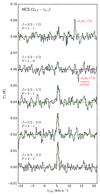Detection of interstellar HCS and its metastable isomer HSC: new pieces in the puzzle of sulfur chemistry
- PMID: 29983448
- PMCID: PMC6031296
- DOI: 10.1051/0004-6361/201832743
Detection of interstellar HCS and its metastable isomer HSC: new pieces in the puzzle of sulfur chemistry
Abstract
We present the first identification in interstellar space of the thioformyl radical (HCS) and its metastable isomer HSC. These species were detected toward the molecular cloud L483 thanks to observations carried out with the IRAM 30m telescope in the λ 3 mm band. We derive beam-averaged column densities of 7 × 1012 cm-2 for HCS and 1.8 × 1011 cm-2 for HSC, which translate to fractional abundances relative to H2 of 2 × 10-10 and 6 × 10-12, respectively. Although the amount of sulfur locked by these radicals is low, their detection allows to put interesting constraints on the chemistry of sulfur in dark clouds. Interestingly, the H2CS/HCS abundance ratio is found to be quite low, ~ 1, in contrast with the oxygen analogue case, in which the H2CO/HCO abundance ratio is around 10 in dark clouds. Moreover, the radical HCS is found to be more abundant than its oxygen analogue, HCO. The metastable species HOC, the oxygen analogue of HSC, has not been yet observed in space. These observational constraints are confronted with the outcome of a recent model of the chemistry of sulfur in dark clouds. The model underestimates the fractional abundance of HCS by at least one order of magnitude, overestimates the H2CS/HCS abundance ratio, and does not provide an abundance prediction for the metastable isomer HSC. These observations should prompt a revision of the chemistry of sulfur in interstellar clouds.
Keywords: ISM: clouds; ISM: molecules; astrochemistry; line: identification; radio lines: ISM.
Figures


References
Grants and funding
LinkOut - more resources
Full Text Sources
Other Literature Sources
